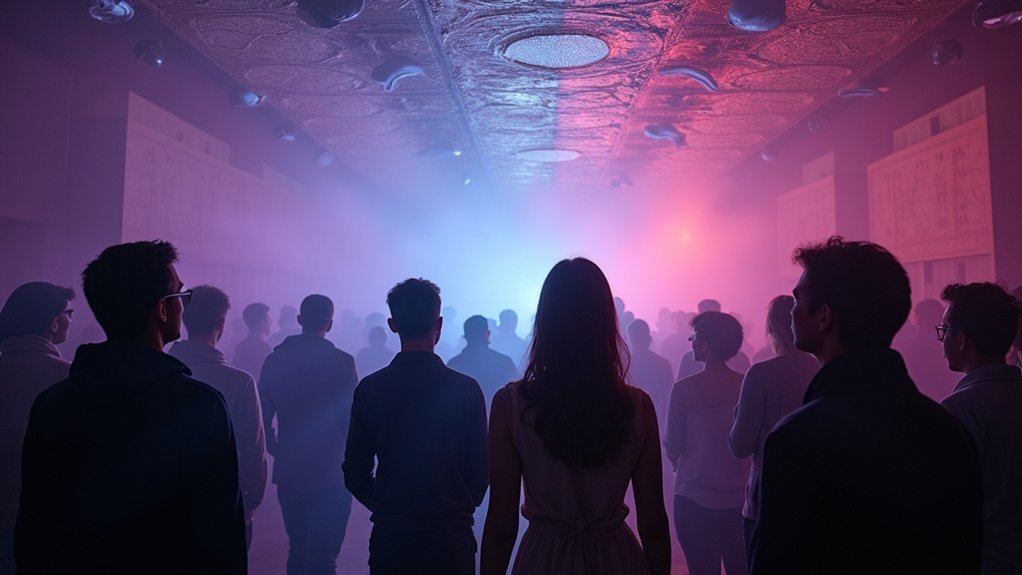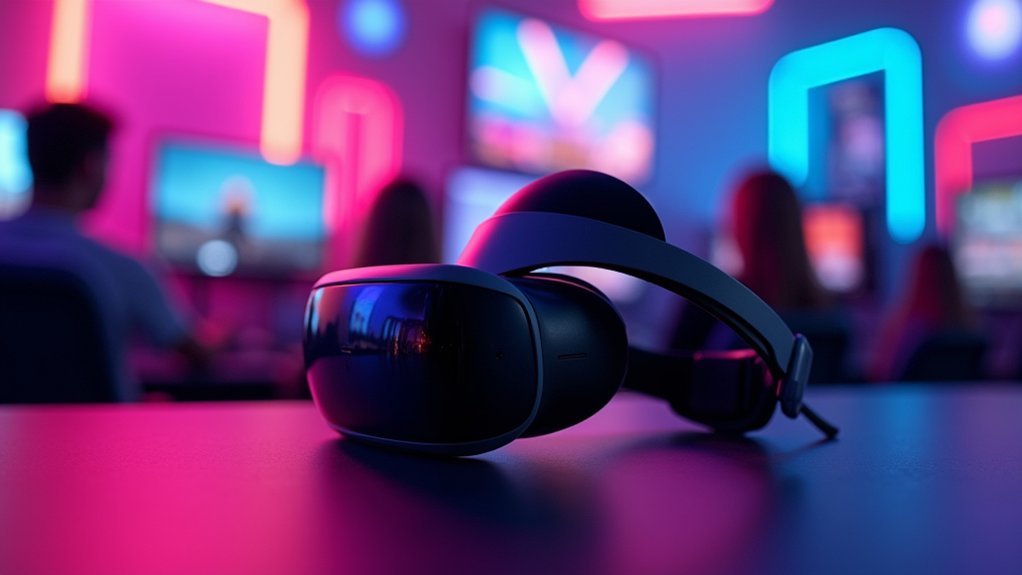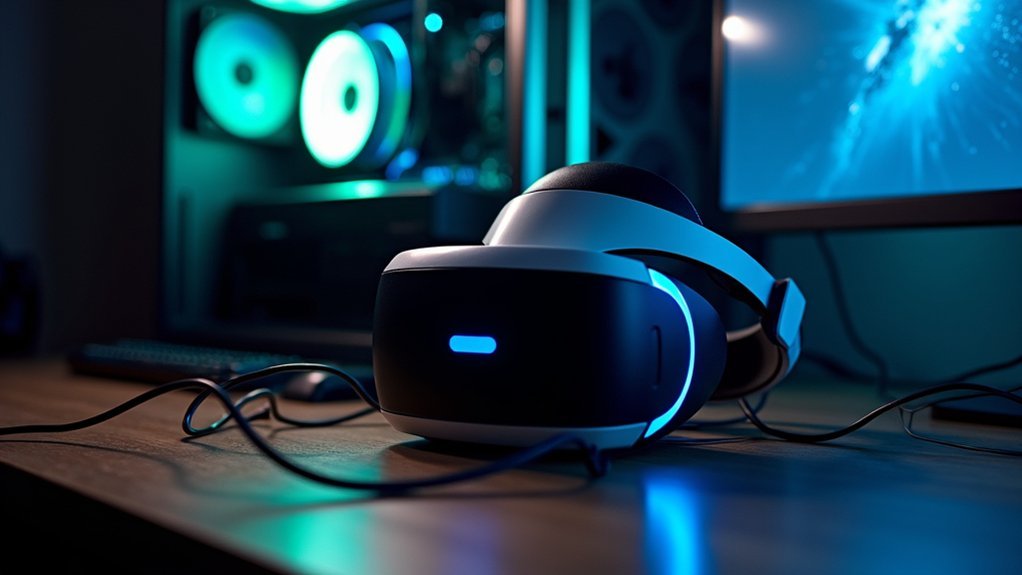Your brain processes spatial audio through sophisticated neural pathways that tap into primitive survival mechanisms used for navigation and threat detection. When you hear 3D sound, your auditory cortex activates the same regions responsible for memory and emotion, creating authentic virtual environments that foster deeper psychological connections. Spatial audio also engages multisensory processing centers, synchronizing auditory and visual cues for heightened emotional responses that traditional stereo simply can’t match. Understanding the technical foundations reveals even more fascinating insights.
The Psychology Behind Spatial Sound Perception

When you hear a sound, your brain instantly performs complex calculations to determine where it’s coming from, using subtle differences in timing and volume between your ears. This spatial sound perception relies on interaural time differences and level variations that create detailed mental maps of your environment.
Your brain processes these cues through the Head-Related Transfer Function, which accounts for how sound waves interact with your unique anatomy.
The psychological impact of this processing is profound. Immersive audio experiences trigger stronger emotional engagement because they activate the same neural pathways used for real-world navigation and survival.
When sounds appear to originate from your surrounding environment rather than inside headphones, you experience externalization that makes virtual worlds feel authentically real, creating deeper connections and more memorable experiences.
How Spatial Audio Activates Multiple Sensory Pathways
When you experience spatial audio, your brain doesn’t just process sound through auditory pathways alone—it creates a complex web of neural connections that integrate multiple sensory systems simultaneously.
Your brain’s multisensory processing centers work together to combine auditory information with visual and even tactile cues, creating a unified perception that feels remarkably real.
This sophisticated cognitive response mechanism explains why you’ll feel genuinely present in virtual environments when spatial sound aligns perfectly with what you’re seeing and experiencing.
Brain Processing Pathways
Because your brain processes spatial audio through sophisticated neural networks, you’re experiencing far more than simple left-and-right stereo separation. Your auditory system analyzes Interaural Time Difference (ITD) and Interaural Level Difference (ILD) to determine where sounds originate in three-dimensional space.
These processing pathways activate regions associated with memory and emotion, making your auditory experiences considerably more impactful.
When you encounter spatial audio in immersive environments, your brain creates cohesive multi-sensory experiences by integrating sound with visual information. This neural coordination triggers heightened emotional responses and increases physiological markers like heart rate variability.
Your spatial awareness becomes enhanced as multiple sensory pathways work together, creating deeper engagement than traditional audio formats can achieve through your brain’s sophisticated sound processing mechanisms.
Multisensory Neural Integration
As spatial audio reaches your ears, it triggers a cascade of neural activity that extends far beyond your auditory cortex into visual, motor, and memory processing centers. This multisensory neural engagement creates profound immersive experiences by activating interconnected brain networks simultaneously.
Your brain processes spatial cues through ITD and ILD while integrating visual information, enabling precise sound localization that feels natural and believable. HRTF technology personalizes these auditory signals to match your unique anatomy, strengthening emotional connections to the virtual environment.
| Neural Pathway | Function |
|---|---|
| Auditory Cortex | Processes sound direction and distance |
| Visual Cortex | Integrates audio-visual spatial matching |
| Motor Cortex | Prepares movement responses to sounds |
| Limbic System | Generates emotional responses to audio |
This synchronized neural activation creates the compelling realism that defines truly immersive spatial audio experiences.
Cognitive Response Mechanisms
While your auditory cortex initially processes spatial audio signals, the cognitive response mechanisms extend through interconnected neural networks that simultaneously activate visual processing centers, motor planning regions, and emotional memory circuits.
This multifaceted activation creates cognitive responses that transcend traditional audio processing, establishing deeper connections between sound perception and personal experience.
When spatial audio replicates real-world acoustics through ITD and ILD principles, your brain recognizes familiar auditory patterns that trigger emotional engagement pathways.
These mechanisms explain why immersive experiences feel more authentic—your cognitive system processes spatial cues as genuine environmental information rather than artificial sound.
The enhanced auditory processing creates stronger memory formation and emotional resonance, making spatial audio particularly effective in applications requiring deep user involvement and sustained attention.
Technical Foundations That Enable Immersive Audio Experiences
You’ll discover that three core technical foundations work together to create truly immersive audio experiences that transport you beyond traditional stereo listening.
HRTF processing fundamentals shape how your brain interprets directional sound cues, while decorrelation signal techniques transform simple mono sources into rich, spatially distributed soundscapes.
Cross-talk cancellation methods guarantee that each ear receives precisely the intended audio information, eliminating interference that would otherwise compromise your spatial perception.
HRTF Processing Fundamentals
When sound travels from its source to your ears, your head, torso, and outer ears dramatically alter the audio signal through filtering, reflection, and diffraction—a phenomenon captured by Head-Related Transfer Functions (HRTF).
These measurements, typically recorded in anechoic chambers using specialized microphones and head simulators, create unique acoustic fingerprints that enable precise sound localization.
HRTF processing transforms ordinary audio into spatial audio through convolution techniques, where developers mathematically apply these transfer functions to simulate directional sound effects.
Since everyone’s anatomy differs, your personal HRTF creates distinct audio signatures that make individualized spatial experiences possible.
Modern audio processing systems leverage HRTF data to craft convincing three-dimensional soundscapes, delivering immersive experiences that trick your brain into perceiving realistic directional audio in virtual and augmented reality applications.
Decorrelation Signal Techniques
Decorrelation techniques manipulate audio signals to create convincing spatial depth where none originally existed.
When you’re working with mono sources, these methods transform flat recordings into rich, three-dimensional soundscapes that engage your spatial perception naturally.
By adjusting phase and amplitude relationships, you’ll experience sounds appearing from different directions and distances, fundamentally enhancing your immersive sound experience.
Here’s how decorrelation techniques improve your sound reproduction:
- Phase manipulation – Creates the illusion of directional audio from mono sources
- Amplitude adjustment – Establishes perceived distance and positioning within the soundfield
- Multiple speaker integration – Generates diffuse ambient sound through coordinated playback systems
- ITD/ILD simulation – Mimics natural hearing cues for authentic spatial positioning
Proper calibration prevents artifacts while maximizing immersion, making careful parameter tuning essential for professional results.
Cross-Talk Cancellation Methods
While decorrelation techniques enhance spatial perception through signal manipulation, cross-talk cancellation (CTC) methods attack a different fundamental challenge in immersive audio reproduction.
You’ll encounter unwanted sound leakage between channels that destroys the precise positioning of audio sources. CTC algorithms actively filter out this interference, dramatically improving your sound localization abilities.
When you’re experiencing spatial audio formats like Dolby Atmos, cross-talk cancellation guarantees each channel maintains its distinct identity.
You’ll notice how CTC extends your listening sweet spot, allowing movement within larger spaces without losing audio quality.
These audio technologies recreate natural auditory cues your brain relies on for directional hearing. The result transforms your perception, delivering truly immersive experiences where sounds appear to originate from specific locations around you with remarkable accuracy.
Binaural Processing and Head-Related Transfer Functions in VR
As you put on a VR headset, your brain expects to hear sounds that match the visual environment around you, and binaural processing makes this possible by mimicking how your ears naturally capture audio in the real world.
This technology uses two microphones to simulate natural hearing, creating realistic 3D soundscapes that transform your virtual experience.
Head-Related Transfer Functions serve as mathematical blueprints that map how your head, ears, and torso shape incoming sound waves.
Here’s how this enhances your VR journey:
- Precise sound localization lets you identify exactly where audio sources originate
- Enhanced spatial awareness helps you navigate virtual environments naturally
- Increased presence makes you feel genuinely part of the experience
- Personalized audio profiles can be tailored to your unique anatomy for ideal immersive experiences
Overcoming the Cone of Confusion for Precise Sound Localization

Despite these sophisticated HRTF technologies, your brain still encounters a perceptual challenge known as the Cone of Confusion—specific spatial zones where multiple sound sources can produce nearly identical audio cues at your ears. This phenomenon creates ambiguity in localization, potentially breaking immersion in virtual environments.
Modern spatial audio systems combat this challenge through advanced techniques like Interaural Time Difference (ITD) and Interaural Level Difference (ILD). These methods enhance your ability to distinguish sound directions by manipulating timing and volume differences between your ears.
Additionally, decorrelation techniques create diverse sound fields that prevent sounds from appearing to originate from single points. Implementing personalized Head-Related Transfer Functions tailored to your unique anatomy, combined with subtle frequency and amplitude variations, considerably reduces Cone of Confusion effects and delivers precise sound localization.
Decorrelation Techniques for Creating Expansive Soundscapes
When you listen to natural environments, sounds don’t arrive at your ears as isolated, pinpoint sources—they create rich, enveloping soundscapes that surround you from multiple directions.
Decorrelation techniques transform mono signals into expansive stereo output, manipulating phase and timing to minimize inter-channel correlation and enhance your perception of spaciousness.
These methods are essential for creating immersive soundscapes:
- Phase manipulation – Adjusts timing relationships between channels to create directional perception
- Multiple speaker positioning – Strategic placement generates robust ambient sound fields
- Parameter tuning – Balances decorrelation strength with audio clarity and fidelity
- Convolution integration – Simulates realistic sound propagation in physical environments
Through careful sound design, decorrelation techniques revolutionize audio playback, delivering spatial audio experiences that truly immerse you in three-dimensional sonic environments.
Real-Time Audio Processing Challenges in Virtual Environments

Creating these expansive soundscapes becomes considerably more complex when you’re working within virtual environments that demand real-time audio processing.
You’ll face significant computational loads that require advanced hardware and optimized algorithms to maintain the low latency essential for immersive sound experiences. Audio rendering delays create noticeable discrepancies between what you hear and see, breaking your sense of presence.
Implementing spatial audio techniques like HRTF demands precise calibration that’s both resource-intensive and complex.
You’ll also encounter bandwidth limitations in multi-user environments, where simultaneous audio streams cause crosstalk and degrade quality.
The cone of confusion presents another hurdle, requiring sophisticated algorithms to guarantee sound source localization remains consistent despite your head movements and changing environmental acoustics.
Cross-Platform Implementation of Spatial Audio Technologies
Cross-platform implementation transforms spatial audio from a niche technology into a mainstream experience that works seamlessly across your headphones, gaming console, smartphone, and smart speakers.
This audio technology revolution enables consistent immersive experiences regardless of your device choice.
Major streaming platforms like Apple Music and Tidal now deliver spatial audio content that adapts to your playback system.
Here’s how cross-platform implementation enhances your audio experience:
- Universal compatibility – Dolby Atmos and THX Spatial Creator guarantee your content works across all devices
- Object-based mixing – Sound designers position audio elements in three-dimensional space for consistent quality
- Industry collaboration – Hardware manufacturers and software developers work together for peak performance
- Competitive advantage – Streaming platforms differentiate themselves through superior immersive experience offerings
Measuring Immersion Quality Through Audio Depth Perception
Building effective cross-platform spatial audio systems requires precise methods to evaluate how well they actually immerse listeners.
Precise evaluation methods determine whether spatial audio systems truly deliver immersive listener experiences across different platforms and applications.
You’ll need to measure audio depth perception accuracy by testing how precisely users can identify sound source locations in three-dimensional space. The Head-Related Transfer Function serves as your primary measurement tool, since individual anatomical differences directly impact spatial audio effectiveness.
You can assess sound localization performance by analyzing Interaural Time Difference and Interaural Level Difference accuracy across different platforms. Testing decorrelation techniques helps you determine how well mono signals transform into convincing stereo depth.
Measuring diffuse sound field quality reveals whether your system creates truly immersive experiences. These quantitative assessments guarantee your spatial audio delivers consistent depth perception across gaming, film, and virtual reality applications.
Frequently Asked Questions
What Is the Difference Between Spatial and Immersive?
You’ll find spatial audio focuses on three-dimensional sound positioning and directionality using technologies like HRTF, while immersive audio encompasses broader multisensory experiences that combine sound with visual and interactive elements for complete engagement.
What Is the Point of Spatial Sound?
You’ll experience sound as if you’re actually there. Spatial audio lets you pinpoint where sounds originate, creating realistic depth and direction that transforms how you engage with music, games, movies, and virtual environments.
What Does Turning on Spatial Sound Do?
Turning on spatial sound transforms your audio into a three-dimensional experience. You’ll hear sounds from all directions—front, back, sides, above, and below—making you feel like you’re inside the action rather than just listening.
What Is the Spatial Sound Effect?
You’ll experience sound positioned around you in three-dimensional space through spatial sound effects. They use advanced audio technologies like HRTF to simulate realistic sound direction and distance, making you feel surrounded by audio.
In Summary
You’ll find that spatial sound transforms your virtual experiences by engaging your brain’s natural audio processing systems. When you hear precisely positioned sounds, you’re accessing the same neural pathways that guide you through real environments. You can’t achieve true immersion without accounting for how your ears naturally decode direction, distance, and space. Master these principles, and you’ll create audio that doesn’t just play around you—it places you inside the experience itself.





Leave a Reply